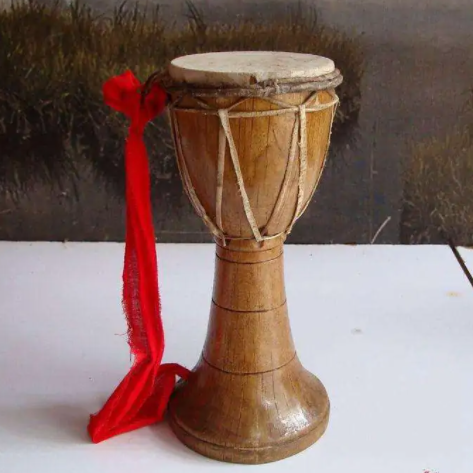guangya overview
 Guangya (pinyin: Guāng yà), also known as Guangtun, is like a foot drum, which means a long tail drum or a short drum. It is an important folk percussion instrument of the Dai people. It is deeply loved by the Dai family and is widely used in the accompaniment of singing, dancing and Dai opera.
Guangya (pinyin: Guāng yà), also known as Guangtun, is like a foot drum, which means a long tail drum or a short drum. It is an important folk percussion instrument of the Dai people. It is deeply loved by the Dai family and is widely used in the accompaniment of singing, dancing and Dai opera.Elephant foot drum is also loved by Jingpo, Wa, Lili, Lahu, Blang, Achang and De'ang people as well as Kemu people. It is an indispensable instrument in singing and dancing of all ethnic groups. The shape of the elephant drum looks like an exquisite goblet. It is made of a whole piece of wood (or several pieces of wood glued together), the whole body is hollow, and the upper end is a cup-shaped resonance body. The cowhide strip is tightened, tethered to the lower part of the drum shell, and its tension can be adjusted. The outer surface of the drum body is painted, the drum waist and the lower half of the drum are carved with decorative patterns, and some are also tied with flower ribbons and colored balls on the drum body.
The drum body is often decorated with pictures, most of which are peacocks, and sometimes a few peacock feathers are inserted in the dance. Peacocks are the most cherished and loved birds of the Dai people. They represent good luck and good life. yearning and pursuit. Similarly, the elephant foot drum is shaped like an elephant's foot, and in the hearts of the Dai people, the elephant symbolizes a prosperous harvest and a good life. Peacocks and elephants were seen from the elephant foot drum, which all showed the good wishes of the Dai people.
When playing, the drum belt is slung over the shoulder, the drum body is placed diagonally on the left hip, the drum face is forward and high, the drum tail is facing the ground, the center of gravity is on the right foot, the left foot is slightly bent, and the toes are on the ground. The body leans slightly to the right. Hold the edge of the drum frame with your left hand, beat the drum face alternately with food, middle, nameless, little finger and right hand, and beat the drum with your right hand with a half-clenched fist. Playing methods include forebeat, dull beat, finger beat (with one finger), palm beat and boxing. When playing the climax or when the mood is intense, even the elbows, soles and knees also participate in drumming, bending over and twisting, in a variety of poses. Different sounds and complex rhythms can be played, and they can be varied.
In the old days, Guangya mainly tapped in Theravada Buddhist monasteries for religious affairs, but only tapped but not danced. Later, it was spread among the people, and the form of dancing while playing appeared, but it was only performed by the performer alone. Because the drum is too heavy, Guangya does not play it alone. It is often combined with cymbals and cymbals to perform various folk dances such as "Peacock Dance", "Red Deer Dance", "White Elephant Dance", "Scarf Dance" and so on. accompaniment. In Xishuangbanna Dai Autonomous Prefecture, during the slack season, village drummers will compete in Guangya competitions, and monks from Buddhist temples will also participate. Those with beautiful drum sounds and superb skills can win prizes. In the percussion bands and Dai opera bands mainly based on Guangya, Guangya is often used as a color rhythm instrument.
- Pinyin:Guāng yà
- definition:Important folk musical instruments of the Dai people
- use:For singing and dancing and Dai opera accompaniment
- pop nation:Jingpo, Wa, Lili, Lahu, Brown, etc.
overview of other similar instruments
- sanyanxiao overview
- Daguangxian overview
- Leiqin overview
- hahao overview
- yandundagu overview
- Han Xiaozheng overview
- Fang Xiang overview
- guanzi overview
- zhuqin (Dao Qin) overview
- zhuiqin overview
- bangzi overview
- three-stringed piano overview
- Gehu overview
- xiao overview
- xiaokonghou overview
- Konghou overview
- Sheng overview
- suona overview
- hulusi overview
- gushao overview
 渝公网安备 50010702504639号
渝公网安备 50010702504639号